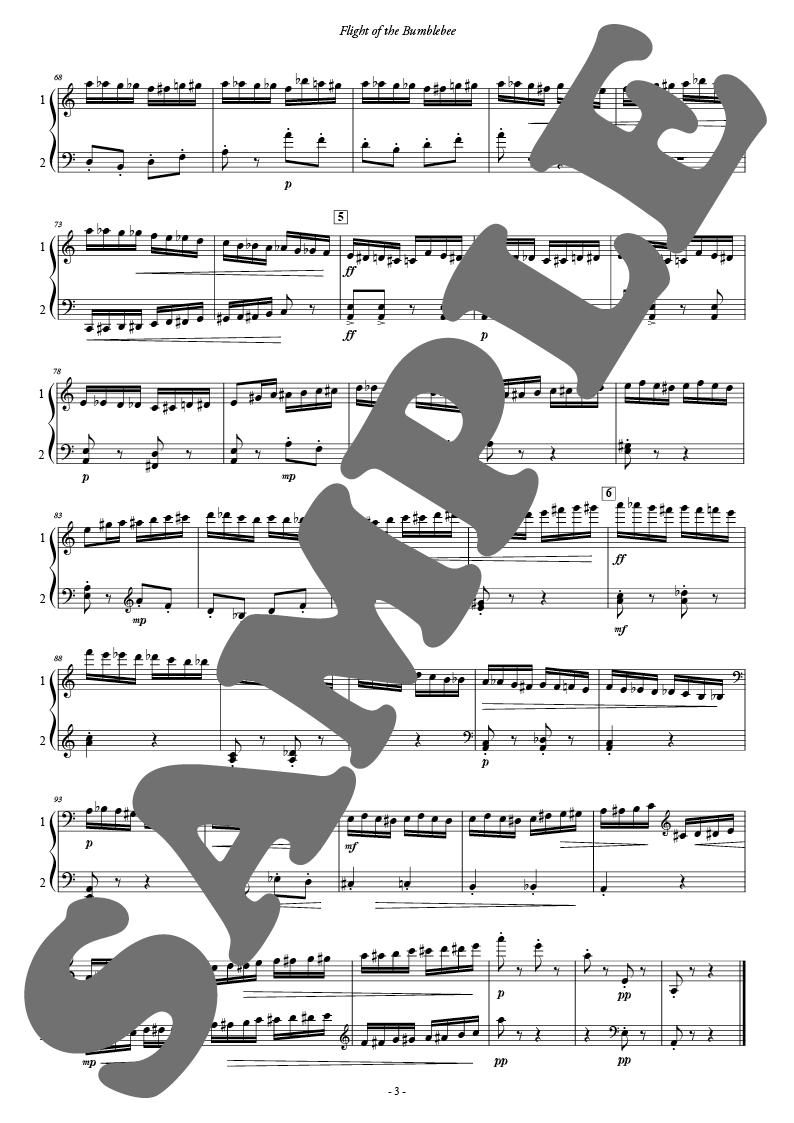熊蜂の飛行(マリンバ連弾):ニコライ・リムスキー・コルサコフ arr. 菅原淳 [打楽器2重奏]
・1配送につき税込11,000円以上のご注文で国内送料無料
・コンビニ後払い、クレジットカード、銀行振込利用可
・[在庫あり]は営業日正午までのご注文で即日出荷
・International Shipping
- 作曲: ニコライ・リムスキー・コルサコフ
編曲: 菅原淳 - 演奏時間:0:01:20
フォスターミュージック/FME-0484
- 概要
- 編成/曲目
- 補足
- ENGLISH
熊蜂の飛行(マリンバ連弾)
この曲は、とにかく早いテンポ、楽器の超絶技巧で聴いている人を驚かせるような事もあり、弦楽器、管楽器、ピアノそして打楽器にもよく編曲されています。今回は読売日本交響楽団打楽器奏者の西久保友広さんの委嘱で編曲しました。
この熊蜂の飛行はマリンバ1台での2重奏で、2人の呼吸を合わせ、途中高音パートと低音パートが入れ替わったりし、とても忙しいアレンジになりました。
マリンバでの半音階で、熊蜂が飛んでいる様子を表現しています。(菅原淳)
●演奏上のアドバイス
半音階の動きは白鍵と黒鍵の移動がスムーズに演奏できるようにしたいですね!練習で一度マレットを持たずに人差し指のみでマリンバで練習してみましょう。腕の感覚が掴めたらマレットを持って演奏してみるとだいぶ演奏しやすくなると思います。また、マレットを高く上げすぎないようにするとバタバタせずテンポも早くしやすいです。左右の音色や音量の差が出ないように意識して演奏するとスムーズに演奏できると思います。
練習番号2のところは積極的にクレッシェンドをかけて山場を作ります。ディミヌエンドが疎かになりやすいですがこれをしっかりすることによって奥行きが出てきます。練習番号3はオクターブのユニゾンで印象的な「見せ場」なので勢いがなくならないようにしましょう。練習番号4はpとppなので繊細にして前半との対比を作るように。ゴツゴツしやすいのでスムーズに演奏できるといいですね!
練習番号5の2ndパートはリズミカルに!練習番号6の2小節前からはラストスパート。高音で音がかすれやすいのでしっかり鳴らすようにしましょう。(西久保友広)
仕様
- アーティスト
- 作曲: ニコライ・リムスキー・コルサコフ
編曲: 菅原淳
- 演奏形態
- 打楽器
- 編成
- 2重奏
- 演奏時間
- 0:01:20
- 商品カテゴリ
- アンサンブル楽譜
- 出版社 / 品番
- フォスターミュージック / FME-0484
- JANコード
- 4560318476608
- 発売日(年)
- 2021/06/30
- キーワード
- ,クラシックアレンジ
楽器編成
- Marimba (2Player)
菅原淳(Atsushi Sugahara)
大阪生まれ。東京藝術大学卒業。フランス政府給費留学生として、パリ・コンセルバトワールに留学。
74年、ラ・ロッシェル国際打楽器コンクール第1位。グループ「3マリンバ」、アンサンブル「ヴァン・ドリアン」を結成、作曲家に曲を委嘱し、数多くの日本初演をする。
80年、パリで行われた国際打楽器コンクールの審査員を務める。
83年、中島健蔵音楽賞を受賞。平成7年度文化庁芸術祭優秀賞を受賞。
99年、朝日現代音楽賞を受賞。CD「菅原淳/木と皮の鼓動」「花と星」をリリース。
打楽器アンサンブル「パーカッション・ミュージアム」と「パーカッション・ギャラリー」の主宰。
38年間、読売日本交響楽団で主に首席ティンパニ奏者を務めた。
現在、東京音楽大学客員教授、昭和音楽大学客員教授。
- サイズ
- A4/1cm未満
FLIGHT OF THE BUMBLEBEE:Composer: Nikolai RIMSKY-KORSAKOVArranger: Atsushi SUGAHARA
This piece is often arranged for strings, wind instruments, the piano, and percussion instruments because of its fast tempo and the virtuosity required of performers that often surprise the audience. This arrangement was commissioned by Tomohiro Nishikubo, percussionist of the Yomiuri Nippon Symphony Orchestra.
This arrangement is a duet for a single marimba. The two performers have to match their breathing while swapping treble and bass parts midway through the piece, making this arrangement one that is highly engaging.
The chromatic scale played on the marimba is inspired by the movement of flying bumblebees. / Atsushi Sugahara
PERFORMANCE ADVICE
I requested a piece where the chromatic scale transitions smoothly between the white and black keys of the marimba! When practicing on the marimba, try doing it with only your index fingers first without using mallets. Once you get a feel for the arm movement needed, you will find it a lot easier to play with mallets. It is also important not to raise the mallets too high as that would allow you to speed up without exaggerated movements. You can also achieve a smooth performance if you ensure uniformity in tone and volume across your left and right hands.
In Section 2, build up the crescendo in an energetic way to create a climax. It is easy to neglect the diminuendo, but paying attention to it will help you to create depth in your performance. Section 3 is where you will find the piece's memorable "highlight" featuring octave unisons, so make sure you don't lose momentum here. Section 4 has p and pp parts that need to be played with subtlety to create contrast with the first half. This section can easily become too chaotic, so try your best to achieve a smooth flow!
The second part in Section 5 should be played in a rhythmic manner! The piece reaches its last spurt two bars before Section 6. The high notes here tend to blur into one another, so make sure they are articulated distinctly. / Tomohiro Nishikubo
Specifications
- ARTIST
- Composer: Nikolai RIMSKY-KORSAKOVArranger: Atsushi SUGAHARA
- INSTRUMENTATION
- Percussion / Duet (2parts)
- DURATION
- 0:01:20
- PRODUCT TYPE
- Set / ENSEMBLE
- PUBLISHER / Code
- fostermusic Inc. / FME-0484
- JAN
- 4560318476608
- RELEASE
- 2021/06/30
- OVERSEAS SHIPMENT
- Ask
- EUROPEAN PARTS
- Not Included
For foreign customers,
You can now purchase from overseas via WorldShopping BIZ.
Study scores, ensembles, and CDs can be ordered directly from our website.
Rental sheet music and some other items are not covered by this cart system, so please contact us by email.
7agpr9rwglwc
〈4月〉先着200名様|会員限定クーポン
対象カテゴリ
- 国内出版社 > フォスターミュージック
会員限定
¥1,000 OFF
残発行枚数:189
下限金額:¥5,500
有効期間:2025/04/01 ~ 2025/04/30

![熊蜂の飛行(マリンバ連弾):ニコライ・リムスキー・コルサコフ arr. 菅原淳 [打楽器2重奏]](/html/upload/save_image/FME0484_1.png)











